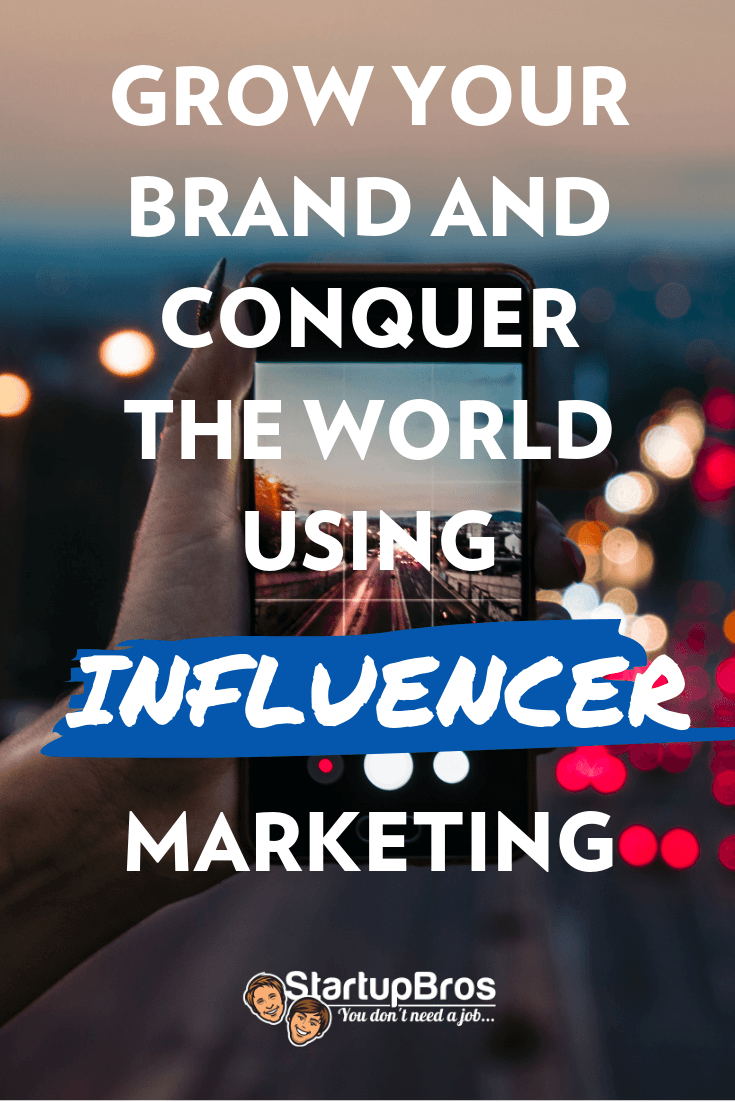
Partnering with an influencer on social media for an influence marketing campaign is huge for boosting your brand’s popularity.
Macro-influencer marketing allow your brand to reach consumers who might otherwise never have heard of it. These are endorsements from very well-known influencers.
Micro-influencer marketing helps you target a specific market that listens to the influencer’s recommendations. These are endorsements from lesser-known or niche celebrities and influencers.
We’re going to take a deep dive into celebrity and influence marketing:
- How to find and identify the right influencers for your brand
- Decide how to plan out your campaign
- Learn to get in contact with influencers
On top of that, we’ll also offer advice on things to be wary of; if you’re new to the world of influencer marketing campaigns, there are a lot of potential pitfalls out there.
We’ll point out some of the biggest ones and the steps you can take to avoid them.
Here’s What We’re Covering:
- Find and Identify the Right Influencers
- Planning Out Your Influence Marketing Campaign
- Wrapping This Up…
1. Find and Identify the Right Influencers
Identifying a potential influencer is important, but it’s not half as important as identifying the right influencer. Your idea of an ideal influencer may be an A-list celebrity, but that doesn’t necessarily have to be the case.
Macro vs. Micro Influencers: Which Is Best For You?
There are unknown influencers out there but can make a bigger impact on your bottom line than a household name.
Let’s take a look at the pros and cons between micro and macro influencers.
Macro Influencers
As the name implies, macro influencers are people who are very well-known by a large segment of the population. Now, not all macro influencers are movie stars, but they are all celebrities in their own right. Here’s a perfect example: astrophysicist Neil DeGrasse Tyson. He has a large following, is well respected, and you probably don’t see him on TV or advertisements.
Another example is YouTube star PewDiePie; he may not be a household name, but he has a massive following on social media.
If you’re looking for a way to get your brand in front of a large audience, try a macro influencer. Top influencers have millions of followers across social media, and they can make your startup a household name.
The major drawbacks with macro influencers are twofold. First, they’re typically very expensive — access to an audience as big as theirs doesn’t come cheap.
Because these macro influencers have large audiences, their recommendations might not necessarily be viewed as authentic. Since they most likely a long track record of various endorsements.
Micro Influencers
On the other side, you have micro influencers.
Depending on your brand and the product or service you offer; micro influencers can be more cost-effective and yield the same or better results.
These influencers don’t have the same size audience as macro influencers, so any campaign of theirs is likely to reach a much smaller audience (most micro influencers have audiences of 10,000-90,000). That said, however, just because the audience is smaller doesn’t mean you’ll get a smaller return on your investment. Micro influencers can be a phenomenal option for startup brands — especially ones that don’t have an endless marketing budget.
Micro influencers offer something that macro influencers typically cannot: authenticity. Because they have smaller followings, micro influencers’ audiences tend to view the influencer as genuine, and they’re much more likely to act on the influencer’s endorsement.
Not only that, but audiences are more likely to pass on a recommendation to their friends, family and colleagues when it comes from someone they trust. So while the initial reach of micro influencers is more limited than their better-known counterparts, you have the potential over time to reach an audience that’s comparable in size to that of a macro influencer.
Tools to Find Influencers
You need to create a list of influencers. There are a lot of different tools online that you can use to find influencers that would be a good fit. Buzzsumo is great if you are looking to find influencers within Twitter, and Celebrity Endorsers (Disclosure: our product) is great if you are trying to find macro influencers and celebrities.
Using BuzzSumo is pretty easy: all you need to do is head to the site, type in the field of your business (like fashion or music, for example), then click “Go!”
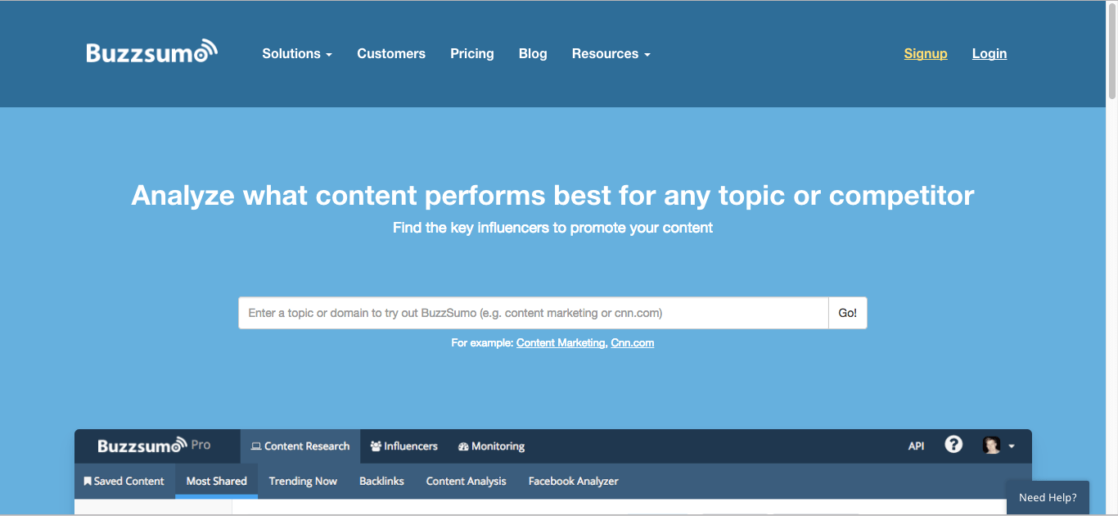
The next page will show you what kind of content performs best for your audience, which will help you figure out the kind of campaign you want to run.

Best of all, at the top of the screen, you can click “Influencers” and immediately be presented with a list of micro influencers who have strong track records of success on campaigns in your field.
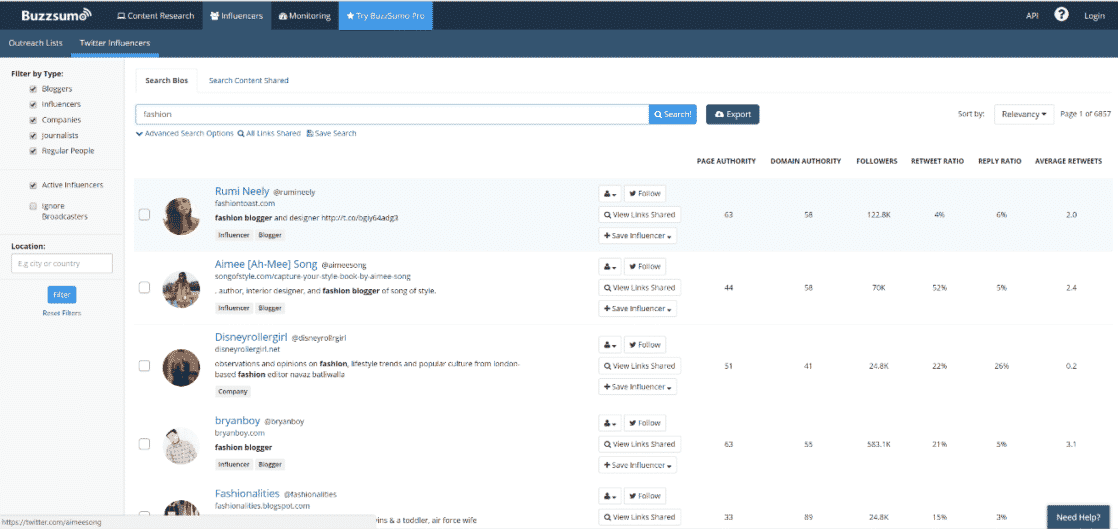
From there, you can go through your options, select the influencer you think is the best fit, and reach out to them to start a conversation.
With Celebrity Endorsers, you can filter influencers by their interests, previous endorsements, and the charities and causes that they support. You can do this by clicking on the celebrities link on the homepage.
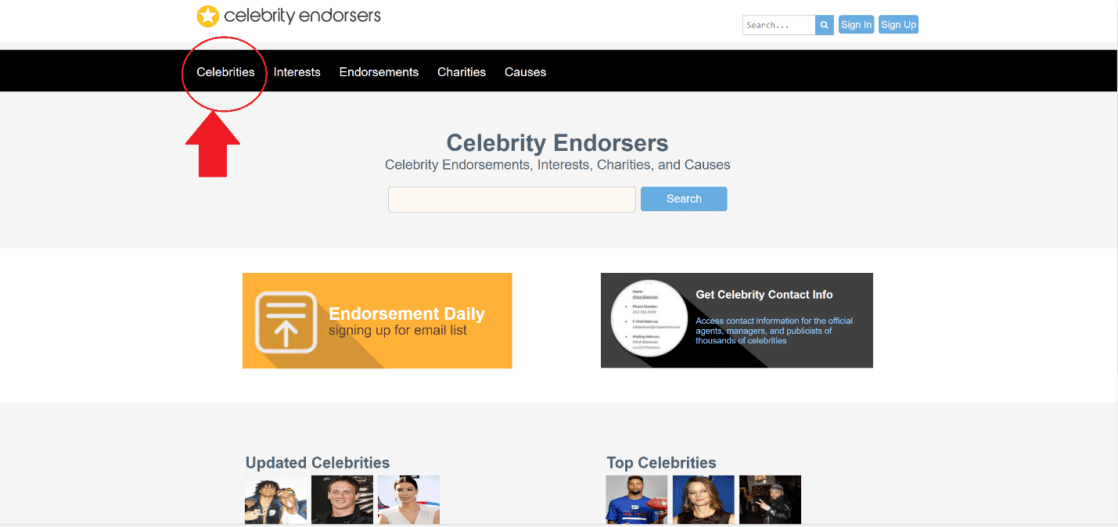
Based on your selections, the site will provide you with a list of celebrities whose interests align with your brand. Once you select a celebrity, you’ll be presented with their interests, past endorsements, any charities they’re affiliated with, and any causes they support publicly. The profiles also include links to their various platforms (social media, their website, etc.) so you can reach out and start a conversation.
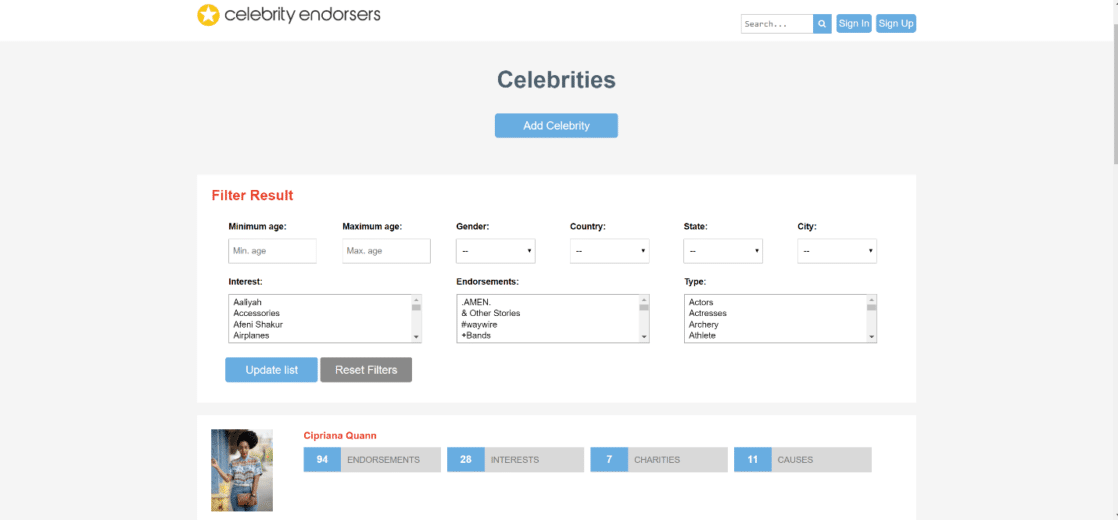
Don’t Overlook Social Media as an Outreach Tool
Most social networks come with their own set of tools which you can utilize to find influencers for your campaigns. In the past I have used, the tools already provided by Facebook, Twitter, and Instagram to find specific influencers for our campaigns that were already using the brand that I was promoting. For example, when search I was searching for influencers for Gorilla Life, a chlorophyll drink, I utilized Twitters search to find influencers that were already talking about the brand by utilizing keywords and hashtags. By doing this I was able to build a list of people who were already advocates of the brand.
I discovered that there were some high-profile influencers that were fans of the brand, and had already posted about liking the brand in the past. I reached out to them either directly, or though their representatives, and offered to send them product for free, with no strings attached. Most everybody that I reached out to accepted, and most of them ended up posting about the brand again organically, because we sent them product for free.
2. Planning Out Your Influencer Marketing Campaign
Setting Goals and KPIs
What are your key performance indicators (KPIs) for the campaign? By knowing your goals ahead of time, you’ll be better able to plot out exactly how you can reach them — and what kind of campaign you’ll need to run to do it. Your specific KPIs will vary depending on your brand, but some important KPIs to consider are number of people reached, clickthrough rate, conversion rate, revenue, cost per lead, and organic traffic.
Because of their audience’s perception of them as authentic, the right micro influencer can get you higher clickthrough and conversion rates; not only that, but because of the word-of-mouth factor, you can potentially generate a lot more organic traffic. So before you start, weigh all these factors and figure out which are the most important ones to you. Once you’ve done that, you’ll have a better idea of what kind of influencer to use for your campaign.
Campaign Options
The next thing to consider is what you want your influencer marketing campaign to look like. In order to figure out what kind of influencer you need, it’s important that you have a vision for your campaign in mind before you start your search.
There is one main question you need to ask yourself here: what channel (or channels) do you need to utilize? Some of this will depend on your brand and the product or service you offer. For example, if you need a series of short videos or product demos in order to effectively demonstrate how your product or service works, you may want to consider a YouTube campaign. Determining the platform you want to use is an easy way to narrow down your list of potential influencer partners.
Pricing Challenges
There are a couple of challenges in pricing influencer marketing campaigns, and depending on your budget, these challenges can mean the difference between getting a good deal on a marketing agreement with an influencer and spending more than you can afford.
The first challenge with pricing influencer marketing campaigns is that there is no resource that provides transparency when it comes to influencer fees. Secondly, because influencer marketing is still a relatively new field, there isn’t really an existing price structure for influencer campaigns. Not only does the price vary from influencer to influencer, but it can also fluctuate wildly depending on the campaign and the medium — even with the same influencer.
Influencer Marketing Prices Vary Depending on Social Channel
That said, there are some general guidelines available to help you get at least a ballpark idea of what you should be spending on macro influencers. According to DigiDay, here are some of the big ones:
- For Instagram campaigns, a general rate is $1,000 per 100,000 followers the influencer has.
- YouTube campaigns have a higher percentage of success, so the rate should be in the range of $2,000 per 100,000 followers.
- Facebook campaigns should cost around $500 per 100,000 followers. Influencers tend to have lower follower counts on Facebook than on other social media sites, and the success rate
of Facebook campaigns is a bit lower. - For Snapchat campaigns, because follower numbers are unknown, you’ll want to pay according to the number of views the influencer’s Snapchat post gets in a 24-hour period.
$500 for 1,000-5,000 views
$1,000-$3,000 for 5,001-10,000 views
$3,000-$5,000 for 10,001-30,000 views
$5,000-$10,000 for 30,001-50,000 views
$10,000-$30,000 for 50,001 or more views
Remember, these are just ballpark figures — depending on your product and the influencer you’re targeting, your fees may vary. And again (just in case you’ve still got sticker shock), these prices are for macro influencers. Since micro influencers don’t have the same size audience as macro influencers, their prices tend to be a lot lower.
Paying For Influencer Marketing Campaigns
How will you pay for the campaign? You may not have enough liquidity to pay out for a whole influencer marketing campaign, but don’t worry: there are a few ways to structure the cost so you can run a successful campaign without breaking the bank. Depending on your budget and the kind of campaign you want to run, some of these might work better than others.
The first is a fairly straightforward pay-per-post structure, as mentioned above. With these kinds of deals, you pay the influencer for a certain number of posts; the cost per post usually depends on the size of their audience, since you’re paying for access to a certain number of people.
Another option is to pay the influencer on commission. Rather than paying a blanket fee to reach their whole audience, you’ll pay a little bit more for every conversion yielded by the influencer’s endorsement. This is a good option to ensure you get the most bang for your buck, but many influencers don’t want to be paid on commission; you’re paying them for access, and the sales are your responsibility, not theirs.
Getting In Touch With Macro Influencers
If you’re looking for a particular macro influencer, the first step is to figure out who represents them. More often than not, macro influencers (that is, celebrities and other very-well-known influencers) don’t handle their own business deals, including endorsements and promotional campaigns. If you’re hoping to set up a business arrangement with a macro influencer, the first people you should reach out to are their representatives.
You’ll likely need to contact the celebrities or influencer’s agent to discuss any business deals. Simply put, an agent is responsible for finding work for their clients, and they’ll also be your main point of contact for negotiating the contract once you reach that stage. But the agent isn’t the only person involved in the decision-making process; you might also find yourself discussing your business opportunity with the influencer’s manager.
One of the benefits of working with micro influencers is that you don’t need to do a ton of legwork to identify who their agent or manager is, because in all likelihood they don’t have one. You can reach them directly through their social media outlets, and sometimes they’ll even have an email listed.
The standard process for reaching out to influencers or their representatives follows a pretty basic format. Before we get into the specific steps, there are a couple best practices you should keep in mind when reaching out to an agent.
Prepare for Outreach
First, be concise. They may be dealing with a flood of requests every single day. And because they only have a limited amount of time to read each request and decide whether or not it’s worthy of a response, you should be as brief as possible in your initial request. However, you want to provide as many specifics as you can in a limited amount of space. You should keep it to just the key details using the “Who/What/When/Why” format:
• Who are you and what is your brand?
• What do you want them to do?
• When do you need to know whether they’re interested?
• Why do you think your brand is a good match for their client?
Lastly, make sure your initial email includes some sort of call to action (CTA). Emails are more likely to be responded to if you leave the reader feeling as though some sort of action on their part is required.
Here is the general format that I usually use when reaching out to influencers or their representatives:
Influencer Marketing Outreach Template
Hi [name],
I am with [your company], and we’re interested in working with [influencer’s name] on a our brands campaign. The campaign would be [describe what the campaign will look like, and what you want the influencer to do], and we think [influencer’s name] would be a perfect fit. I wanted to see if this opportunity is something [influencer’s name] would be interested in; we would like to kick the campaign off by [date]. Is this something that they would be interested in?
Thank you,
[your full name]
[Company] – with link to company website
[your phone number]
If I have worked with any big influencers or celebrities for the same brand, then I will also name-drop the person in the email as well. I have found this to get an increase in replies when I do this, especially when reaching out to the influencer directly. I usually do this by adding in the email: “We have previously worked with [celebrity 1], [celebrity 2], and [celebrity 3] on previous campaigns.” When listing the celebrity’s name, I would include a link to where they can find the actual campaigns.
Wrapping This Up…
When it comes to taking your brand to the next level, partnering with the right influencer on a marketing campaign is one of the most effective tools you can use to boost brand awareness and drive sales.
It’s important that you not only find the right influencers but be effective in reaching out to the influencers that you want. While setting up a deal that is profitable for your brand. If you want to set your brand apart from all your competitors, a solid, well-planned influence marketing campaign can be a crucial piece of the puzzle.
Have you used influencer marketing in the past? If so, let me know in the comments section what strategy that you use to find and contact influencers.
Please comment below if you have any stories, questions, or suggestions with any part of this. I will be responding to everything immediately for the next couple of days.
Good luck, and talk to you below!

Great tips! Very informative. I have been into influencer marketing via Phlanx platform. Influencer marketing is really rising as a market trend til this new year, 2018. Influencers are crucial to a business’ success.
Really, Influencer marketing is the best method to grow brand.
Thanks for sharing